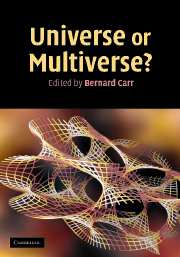Book contents
- Frontmatter
- Contents
- List of contributors
- Preface
- Acknowledgements
- Editorial note
- Part I Overviews
- Part II Cosmology and astrophysics
- 4 Cosmology and the multiverse
- 5 The anthropic principle revisited
- 6 Cosmology from the top down
- 7 The multiverse hierarchy
- 8 The inflationary multiverse
- 9 A model of anthropic reasoning: the dark to ordinary matter ratio
- 10 Anthropic predictions: the case of the cosmological constant
- 11 The definition and classification of universes
- 12 M/string theory and anthropic reasoning
- 13 The anthropic principle, dark energy and the LHC
- Part III Particle physics and quantum theory
- Part IV More general philosophical issues
- Index
- References
10 - Anthropic predictions: the case of the cosmological constant
Published online by Cambridge University Press: 05 July 2014
- Frontmatter
- Contents
- List of contributors
- Preface
- Acknowledgements
- Editorial note
- Part I Overviews
- Part II Cosmology and astrophysics
- 4 Cosmology and the multiverse
- 5 The anthropic principle revisited
- 6 Cosmology from the top down
- 7 The multiverse hierarchy
- 8 The inflationary multiverse
- 9 A model of anthropic reasoning: the dark to ordinary matter ratio
- 10 Anthropic predictions: the case of the cosmological constant
- 11 The definition and classification of universes
- 12 M/string theory and anthropic reasoning
- 13 The anthropic principle, dark energy and the LHC
- Part III Particle physics and quantum theory
- Part IV More general philosophical issues
- Index
- References
Summary
Introduction
The parameters we call constants of nature may, in fact, be stochastic variables taking different values in different parts of the Universe. The observed values of these parameters are then determined by chance and by anthropic selection. It has been argued, at least for some of the constants, that only a narrow range of their values is consistent with the existence of life [1—5].
These arguments have not been taken very seriously and have often been ridiculed as handwaving and unpredictive. For one thing, the anthropic worldview assumes some sort of a ‘multiverse’ ensemble, consisting of multiple universes or distant regions of the same Universe, with the constants of nature varying from one member of this ensemble to another. Quantitative results cannot be obtained without a theory of the multiverse. Another criticism is that the anthropic approach does not make testable predictions; thus it is not falsifiable, and therefore not scientific.
While both of these criticisms had some force a couple of decades ago, much progress has been made since then, and the situation is now completely different. The first criticism no longer applies, because we now do have a theory of the multiverse. It is the theory of inflation. A remarkable feature of inflation is that, generically, it never ends completely. The end of inflation is a stochastic process; it occurs at different times in different parts of the Universe, and at any time there are regions which are still inflating [6,7].
- Type
- Chapter
- Information
- Universe or Multiverse? , pp. 163 - 180Publisher: Cambridge University PressPrint publication year: 2007
References
- 3
- Cited by



